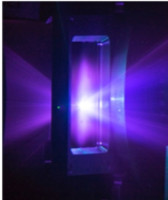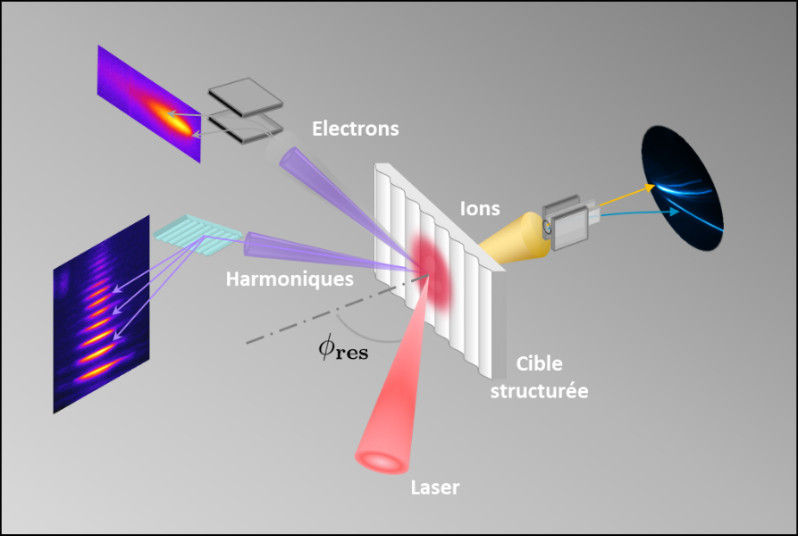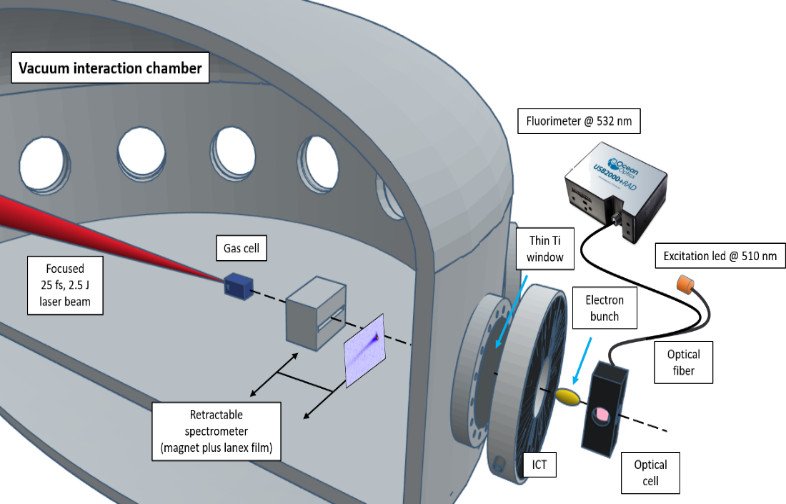Introduction
We study the acceleration mechanisms of electrons and protons triggered by the interaction of a very high intensity laser pulse (>1018 W/cm2, also known as the relativistic regime) with solid or gaseous targets. The particle sources thus created have remarkable properties in terms of brevity, charge, energy and emittance, opening up new perspectives in the fields of gas pedal physics, radiobiology and radiotherapy, as well as imaging.

Structured solid-state targets

The interaction of a laser pulse in the relativistic regime, i.e. at intensities in excess of1018 W/cm2, with a solid or gaseous target generates energetic and brilliant secondary radiation sources, which have been studied for decades as possible alternatives to conventional gas pedals.
At such high intensities, all irradiated material is transformed into plasma within a few optical cycles of the laser pulse. The resulting free electrons can reach near-light speeds, with energies ranging from a few MeV to a few GeV, depending on the plasma density and the relative interaction regime.
Read more
In this context, “supercritical” plasmas are defined as those whose density exceeds the critical density, i.e. the density at which the plasma becomes opaque at the wavelength of the laser used. Typically, these plasmas, whose density is comparable to the density of a solid (ne ≥ 1023 cm3), are obtained in the laboratory by interacting a very intense, short-duration laser beam with a solid target. Long confined almost exclusively to the generation of proton sources
This is due to the exploration of new interaction regimes leading to the generation of more energetic, more numerous and, in some cases, more directional electrons.
One of the most popular strategies is to use micro-structured targets, in particular diffraction gratings. The coupling of this type of target to the laser’s electromagnetic field excites surface plasmons, which are collective electron oscillations at the interface between two materials with different dielectric constants.
In the relativistic interaction regime, surface plasmons are excited when the laser irradiates the grating surface at a certain angle of incidence, known as the resonance angle, which depends mainly on the grating pitch. From an experimental point of view, the temporal contrast of the laser must be sufficiently high so that the pedestal intensity, produced by the amplification of spontaneous emission along the laser chain, does not erase the periodicity of the target before interaction with the peak of the pulse. However, the recent development of techniques for enhancing laser contrast, such as the plasma mirror used on the UHI100 chain, has made it possible to use micro-structured targets in high-intensity laser-plasma interaction.
In this context, experiments carried out at CEA (Saclay, France) have explored the resonant excitation of surface plasmons at relativistic intensities, paving the way for the whole new field of Relativistic Plasmonics
Surface plasmon-induced electron acceleration stands out for its robustness and ease of implementation.
Moreover, the non-linear interaction between the laser pulse and the supercritical plasma also results in the generation of harmonics of the laser frequency. In particular, plasma electrons oscillating across the vacuum interface reflect the incident laser field and cause a frequency shift by the Doppler effect.
This is what we have demonstrated with the very first experimental observation of this effect: the excitation of a surface plasmon turns out to be correlated with an increase in the harmonics emitted along the lattice tangent (up to ≥ 35!)
Plasma mirror

The interaction of a laser pulse in the relativistic regime, i.e. at intensities in excess of1018 W/cm2, with a solid or gaseous target generates energetic and brilliant secondary radiation sources, which have been studied for decades as possible alternatives to conventional gas pedals.
At such high intensities, all irradiated material is transformed into plasma within a few optical cycles of the laser pulse. The resulting free electrons can reach near-light speeds, with energies ranging from a few MeV to a few GeV, depending on the plasma density and the relative interaction regime.
Read more
In this context, “supercritical” plasmas are defined as those whose density exceeds the critical density, i.e. the density at which the plasma becomes opaque at the wavelength of the laser used. Typically, these plasmas, whose density is comparable to the density of a solid (ne ≥ 1023 cm3), are obtained in the laboratory by interacting a very intense, short-duration laser beam with a solid target. Long confined almost exclusively to the generation of proton sources
This is due to the exploration of new interaction regimes leading to the generation of more energetic, more numerous and, in some cases, more directional electrons.
One of the most popular strategies is to use micro-structured targets, in particular diffraction gratings. The coupling of this type of target to the laser’s electromagnetic field excites surface plasmons, which are collective electron oscillations at the interface between two materials with different dielectric constants.
In the relativistic interaction regime, surface plasmons are excited when the laser irradiates the grating surface at a certain angle of incidence, known as the resonance angle, which depends mainly on the grating pitch. From an experimental point of view, the temporal contrast of the laser must be sufficiently high so that the pedestal intensity, produced by the amplification of spontaneous emission along the laser chain, does not erase the periodicity of the target before interaction with the peak of the pulse. However, the recent development of techniques for enhancing laser contrast, such as the plasma mirror used on the UHI100 chain, has made it possible to use micro-structured targets in high-intensity laser-plasma interaction.
In this context, experiments carried out at CEA (Saclay, France) have explored the resonant excitation of surface plasmons at relativistic intensities, paving the way for the whole new field of Relativistic Plasmonics
Surface plasmon-induced electron acceleration stands out for its robustness and ease of implementation.
Moreover, the non-linear interaction between the laser pulse and the supercritical plasma also results in the generation of harmonics of the laser frequency. In particular, plasma electrons oscillating across the vacuum interface reflect the incident laser field and cause a frequency shift by the Doppler effect.
This is what we have demonstrated with the very first experimental observation of this effect: the excitation of a surface plasmon turns out to be correlated with an increase in the harmonics emitted along the lattice tangent (up to ≥ 35!)
Gaseous target
Radiotherapy (RT) is one of the most common tools used to treat many types of cancer. It uses ionizing radiation to destroy cancer cells and reduce tumor size.
More than half of all cancer patients receive radiotherapy during their treatment (source WHO). The major drawback of conventional RT is the intrinsic high-dose irradiation of healthy tissue surrounding the tumor to be treated, with the onset of undesirable short- and long-term side effects.
Read more
This happens because RT uses an external radiation beam whose dose decreases exponentially as it passes through the patient’s body until it reaches the targeted tumor. In recent years, FLASH RT, or the delivery of ultra-high radiation dose rates (UHDR) several orders of magnitude higher than those commonly used (~ 100 Gy/s vs. 5 Gy/min), has emerged as an irradiation modality that enables effective intervention on the tumor while reducing toxicity to surrounding healthy tissue.
Its use would thus increase dose and thus anti-tumor efficacy, with the added advantage of reducing treatment time. Today, FLASH RT is recognized as one of the most promising breakthroughs in radiation oncology, at the crossroads of technology, physics, chemistry and biology. By accelerating electrons through the interaction of intense, ultra-short laser pulses with plasmas (LPA), UHDRs can be produced with ease.
These compact devices generate electron packets of very short duration (~fs) and very high energy (VHEE, 50-250 MeV). What’s more, unlike medical linear gas pedals, which operate at energies below 20 MeV, VHEEs offer a better dose/depth ratio than X-rays and, thanks to their penetration profile, can be used to irradiate most deep tumors in humans. Their use could also enhance the efficacy of FLASH therapy.
Read more
While the scientific community is in the process of tackling the problems inherent in LPA technology (reproducibility and precision of delivered dose, repetition rate, system reliability), the clinical transposition of FLASH radiotherapy nevertheless presents major challenges, particularly in terms of UHDR beam dosimetry. In this regime (> 40 Gy/s), the detectors currently in use are subject to saturation effects, requiring the introduction of correction factors.
Thanks to the experimental resources at our disposal, we decided to explore new methods of radiation detection and dosimetry. Our main objective is to develop a chemical dosimeter adapted to low pulse charge quantities and UHDRs (typically1012 Gy/s) for electron beams from LPAs. In particular, we propose a chemical dosimetry technique for VHEE based on the link between the intensity of fluorescence emission from an appropriately chosen molecule and the dose received.

Title

Lire la suite
zone de texte
Applications : Radiothérapie FLASH

La radiothérapie (RT) est l’un des outils les plus couramment utilisés pour traiter de nombreux types de cancer. Elle utilise des rayonnements ionisants pour détruire les cellules cancéreuses et réduire la taille de la tumeur. Plus de la moitié des patients atteints de cancer reçoivent une radiothérapie au cours de leur traitement (source OMS).
L’inconvénient majeur de la RT conventionnelle est l’irradiation intrinsèque à fortes doses des tissus sains environnant la tumeur à traiter, avec l’apparition d’effets secondaires indésirables à court et à long terme.
Cela se produit car la RT utilise un faisceau de rayonnement externe dont la dose diminue de façon exponentielle en traversant le corps du patient jusqu’à atteindre la tumeur ciblée.
Au cours des dernières années, la RT FLASH, ou la délivrance de débits de dose de rayonnement ultra-élevés (UHDR) de plusieurs ordres de grandeur supérieurs à ceux couramment utilisés (~ 100 Gy/s vs. 5 Gy/min), est apparue comme une modalité d’irradiation qui permet d’intervenir efficacement sur la tumeur tout en réduisant la toxicité pour les tissus sains environnants.
Lire la suite
Son utilisation permettrait ainsi d’augmenter la dose et donc l’efficacité anti tumorale, avec l’avantage supplémentaire de réduire le temps de traitement. À l’heure actuelle, la RT FLASH est reconnue comme l’une des percées les plus prometteuses en radio-oncologie, à la croisée des chemins entre la technologie, la physique, la chimie et la biologie.
L’accélération d’électrons par l’interaction d’impulsions laser intenses et ultra-courtes avec des plasmas (LPA) permet d’obtenir facilement des UHDR. Ces dispositifs compacts génèrent des paquets d’électrons de très courte durée (~fs) et à très haute énergie (VHEE, 50-250 MeV). De plus, à la différence des accélérateurs linéaires médicaux qui fonctionnent avec des énergies inferieures à 20 MeV, les VHEE présentent un meilleur rapport dose/profondeur que les rayons X et, en raison de leur profil de pénétration, peuvent être utilisés pour irradier la plupart des tumeurs profondes chez l’homme. Leur utilisation pourrait d’ailleurs améliorer l’efficacité de la thérapie FLASH.
Si la communauté scientifique est en train de s’attaquer aux problèmes inhérents à la technologie LPA (reproductibilité et précision de la dose délivrée, taux de répétition, fiabilité du système), la transposition clinique de la radiothérapie FLASH présente néanmoins des défis de taille notamment en matière de dosimétrie des faisceaux UHDR.
Dans ce régime (> 40 Gy/s), les détecteurs actuellement utilisés sont sujets à des effets de saturation, ce qui impose l’introduction de facteurs de correction. Grace aux moyens expérimentales dont nous disposons, nous avons décidé d’explorer de nouvelles méthodes de détection et de dosimétrie des radiations. Notre objectif principal est de développer un dosimètre chimique adapté aux faibles quantités de charge par impulsion et aux UHDR (typiquement 1012 Gy/s) pour les faisceaux d’électrons issus des LPA. En particulier, nous proposons une technique de dosimétrie chimique pour les VHEE fondée sur le lien entre l’intensité de l’émission de fluorescence d’une molécule opportunément choisie et la dose reçue.
« Dans le domaine de la radiothérapie, la communauté internationale est en ébullition avec les prémices de ce qui pourrait être une véritable révolution dans les années à venir »
Institut Gustave Roussy – Communiqué de Presse, novembre 2021


